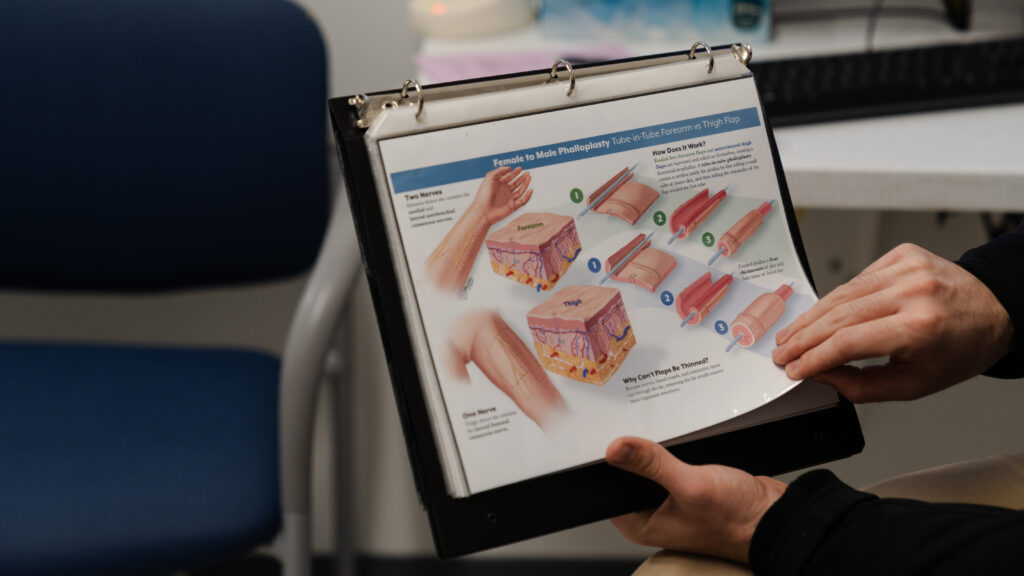
Earlier this year, clinical epidemiologist Gordon Guyatt co-authored three systematic reviews on different types of gender-affirming care for children and young adults: puberty blockers, hormones, and top surgery. The studies were led by a Ph.D. student, and Guyatt was specifically pulled onto the team to make sure the assessment was as objective as possible.
It’s a strength of his. Guyatt, a professor of health research methods, evidence, and impact at McMaster University in Canada, coined the term “evidence-based medicine” in 1991, and has spent more than 45 years focused on reviewing the safety and effectiveness of myriad medical interventions by authoring systematic evidence reviews and contributing to clinical guidelines. His process for the reviews on gender-affirming care was the same as it always is.
Advertisement
“I do the work. I do it well. I present it properly. I make the right conclusions. I put it out in an optimal way. And my work is done,” Guyatt said in an interview. “This is the first time that has not worked out.”
After publication, some people challenged the veracity of the reviews because of their funding. A nonprofit group that questions the efficacy and safety of gender-affirming care for young people, the Society for Evidence Based Gender Medicine, funded the reviews and selected the questions that each would focus on.
SEGM doesn’t explicitly advocate for restrictive policies. But the group consistently emphasizes the weakness of the evidence base for gender-affirming care, emboldening those who do call for bans. Last year, it submitted an amicus brief in the Supreme Court case on Tennessee’s state ban. The brief was in support of neither party, but called gender-affirming care “experimental,” highlighting its “remarkably weak scientific foundation.”
Advertisement
Guyatt said he wasn’t fully aware of SEGM’s involvement in the project. In a statement posted by McMaster University, the authors of the systematic reviews wrote that SEGM “appeared to us as non-trans, cis-gender researchers to be legitimately evidence-based.” But for Guyatt, the real problems came after the work was published.
The McMaster team’s reviews graded the evidence for each intervention as having either low or very low certainty. Guyatt stands by the results, but emphasizes that they do not mean care should be withheld. Opponents of gender-affirming care quickly seized on the findings. In its report on gender dysphoria, the Trump administration, which has campaigned since its first days to restrict gender-affirming care for young trans people, cited Guyatt dozens of times, including his work on evidence assessment and all three recently published reviews on gender-affirming care. The report used the findings to support the administration’s overall argument that gender-affirming care should be questioned and restricted.
“Low quality evidence doesn’t mean it doesn’t work. It means we don’t know. And so, we try,” Guyatt said. “There is, I would say, quite good evidence from the accounts of the individuals who’ve undergone the therapy, that they were really benefited by the therapy.”
To use the systematic reviews as justification for banning gender-affirming care is an “egregious and unconscionable” misuse of the work, he said.
Guyatt spoke with STAT about the science behind the reviews and how political activists have misconstrued it. The conversation has been edited for length and clarity.
How did these systematic reviews on gender-affirming care come about?
There’s a woman named Romina Brignardello, who worked as my postdoctoral fellow. … She subsequently joined our faculty, and I’ve had the privilege of continuing to help her out in a mentor role and also as a collaborator. She came to me and said, “Gordon, I’m doing these systematic reviews, and one of my Ph.D. students is going to be leading the reviews. Would you mind joining the Ph.D. committee?” And in that role, I would naturally be involved in making sure the papers were as high quality as possible. She, in fact, had recognized that this could be controversial, and said, “In particular, Gordon, I’d really like you to take responsibility for making sure that all the decisions we make are as objective and free from bias as possible.”
Advertisement
It was my usual job. I hope that I’m always careful. In all human endeavors, one can be careful, or one can be very careful, or one can be very, very careful. And I always like to be careful and conscientious in what I do, but I might have been on especially high alert in this case.
And what were the overall findings of these reviews?
Well, the major findings were that the studies are extremely limited. And for the outcomes that are probably most important, like the well-being of individuals after they have undergone or not undergone the transition therapies, how people are feeling in their quality of life, emotional function, adjustment … All of the studies in the end gave us only low or very low certainty or quality of evidence about each of those outcomes.
Are there other areas of medicine, or other types of treatment, where there is a similarly low certainty evidence base, but we still provide the care?
Most of what we do. “UpToDate,” which is the most widely used [decision-support tool for clinicians], uses our GRADE approach. It has over 10,000 graded recommendations, and two-thirds of them are weak recommendations. For almost all of them, why they’re weak is that there’s only low or very low quality evidence. Most of the things we do, we only have low or very low quality evidence!
I am a passionate mountain biker, and a couple of years ago, I had an accident. I fell off a bridge into a little stream of water, and hurt my neck fairly badly. I then went to a physiotherapist for advice, and I went to a chiropractor for advice, and I went to an osteopath for advice. Each of those people gave me exercises to do, ways to sit, and various other things. I knew perfectly well that there was only very low quality evidence supporting any of these things that they were advising me, and what I was doing. Nevertheless, I thought: very low quality evidence doesn’t mean it doesn’t work, it means we don’t know. So, maybe it works.
How much did you know about the funding of this work before you got involved?
Advertisement
I knew that the [Society for Evidence Based Gender Medicine] had supported Romina’s work.
I foolishly — I should have, and it’s one of my limitations that I didn’t — I should have known that there was a formal contract at the university. I only found that out later, but that wouldn’t have changed what I would have done.
What makes you say you wouldn’t have changed what you did?
I’m in this situation quite frequently — I’m involved in randomized trials where the pharmaceutical industry gives money. And clearly, we as investigators do everything we can to make sure that the receipt of this money doesn’t influence how we proceed. And maybe we’re all deluded, it’s possible, but we think we do a reasonable job of preventing where the money comes from, from influencing what we do. And I think I’m pretty good at that, and if anything, that’s easier in systematic reviews to keep it clean than in the randomized trials.
So, I would have said, “Has SEGM given us free reign? Then they’re going to stay out of it.” They chose the questions that we were going to address. But then they were committed to leave us alone, which they did.
When did you start thinking that the work was being misconstrued?
That should have happened earlier than it did. But a group in the local trans advocacy community said that these reviews are a problem because they’re funded by SEGM, and as a result, they’re untrustworthy. That was when I started to look more carefully at how the reviews were being used. And I started to recognize that they were being used as justification for legislative decisions to ban gender-affirming care, and for people who supported those decisions.
And it just became extremely evident to me that our work was being used in what I thought was egregious and unconscionable ways. And when it became vividly clear, I felt I needed to do something about it.
What did you decide to do?
The statement was the extra step that was needed. Now, I tried [to do more.] I sent my part of that statement, framed as a letter to the editor, to the journals that published the work, and they would not publish the letter. They came up with what I think are stupid reasons, but anyway, they would not publish the letter.
Advertisement
What were the reasons?
I don’t remember what the reasons were. They were not, as far as I was concerned, coherently expressed.
Then, an editorial in this right-wing Canadian newspaper said the medical associations are misguided in pushing back against the Alberta government [which has attempted to ban gender-affirming care for minors], and again cited my work prominently. I wrote to them and said, “You are misconstruing how my work should be interpreted and used.” And they didn’t publish my letter. So now I was very frustrated. And the university was reluctant to say something, but finally, the university came around and made this post, which fortunately has been noticed.
And despite abuse from both extremes of the political spectrum on the matter — and despite having made some mistakes along the way — I’m still talking to you. And I’m gonna still be out there talking to people. Who knows what other involvement I might have in the issue. I’m ready, potentially, for other involvement.
In 2023, the American Academy of Pediatrics reaffirmed its policy position for gender-affirming care, while simultaneously saying it would perform a review of the evidence. At the time, you said to the New York Times that the move was “putting the cart before the horse.” You also said that European policies were more aligned with the evidence than American policies. Do you stand by those comments?
The Europeans had done reviews, so if the pediatricians had said, reviews are available, and our position is consistent with the reviews, great. But they said, no, we’re going to make a recommendation, and now we’re going to look at the evidence to see whether our recommendation is right. That seemed like a very peculiar way to proceed to me.
A lot has changed since then. Specific policies differ throughout Europe, but in the U.K., for example, puberty blockers are now restricted so that they can only be provided to young people in a research context. What do you think of the way different European countries have since approached this care for young people?
Advertisement
It would be great to get some high-quality evidence —
But what do we do in the meantime?
I’m not a pediatrician, I don’t do adolescent medicine, I don’t do medicine in this area. So, everything that I’ve picked up is from talking to people. This is an intervention which is a very serious intervention, to start using hormones in people and adolescents. And it seems clear it should be done with caution. Saying [it can be done] in research only has some appeal. However, if you say “in research only” and the potential for being involved in the research can accommodate 1% of the individuals seeking care, then that’s not acceptable.
So if you’re saying research only, you had better put in the resources to really gear up the research so that individuals who pass the hurdles, that it would be reasonable to offer them the care, have the care available.
Your work was cited in the U.S. Department of Health and Human Services report on gender dysphoria. That was one of a few major reports on the topic that has been published recently, including the Cass Review out of the U.K. last year, a report out of Utah that was requested by the same legislators who had already passed a state ban, and another from medical societies in Germany, Austria, and Switzerland. The reports all came to varyingly different conclusions. Broadly, how can different reports based on the same body of evidence come to such different conclusions?
When people disagree, there are two possibilities. Number one, they disagree on the evidence, and what the evidence shows us. With the evidence on the net benefit of the therapies, some people interpret the evidence as, “Okay, we’re not sure anybody benefits.” Not so. Just as we’re sure that some people are harmed, there is, I would say, quite good evidence from the accounts of the individuals who’ve undergone the therapy, that they were really benefited by the therapy. Personally, I think that’s sufficient to say there are some people who are benefited by the therapy.
Advertisement
The next reason that people disagree is different values and preferences. So, at least one major issue in values and preferences is to what extent do we value the autonomy of the individuals involved? And another competing value is avoiding harm. And there’s different types of harm.
There could be the harm that people who make the decision then decide it was a bad decision. And there are some people who’ve been through that who describe quite substantial suffering as a result of having made the wrong decision. There’s another type of harm when people would have benefited and do not get the benefit, if the care is denied to them.
If we put minimal or zero value on patient autonomy, and a very high value on avoiding harm to the — what seems clear — minority of individuals who, had they gone forward, would be harmed, then banning [gender-affirming care] would be a reasonable position. Those values and preferences that I’ve just described are extremely problematic from my point of view.
I would say the values and preferences of those who are banning it, I think, come from a broader anti-trans perspective. But that’s a jump. It may be articulated in various ways, but the fundamental position of “we put little or no value on the autonomy of the individuals involved” is key to taking the line that we’re just going to deny this to people.
Anything else you want to share?
Some have criticized me for abandoning science, for taking a political position beyond the science. This is not my abandoning science. I’m very involved in clinical practice guidelines. There is a science of moving from evidence to decisions, and it involves being able to specify the key elements driving the decision, and then taking a position about those elements. The science of decision making tells us that there are two fundamental things. What do you think of the evidence, and what are your values and preferences around applying that evidence.



